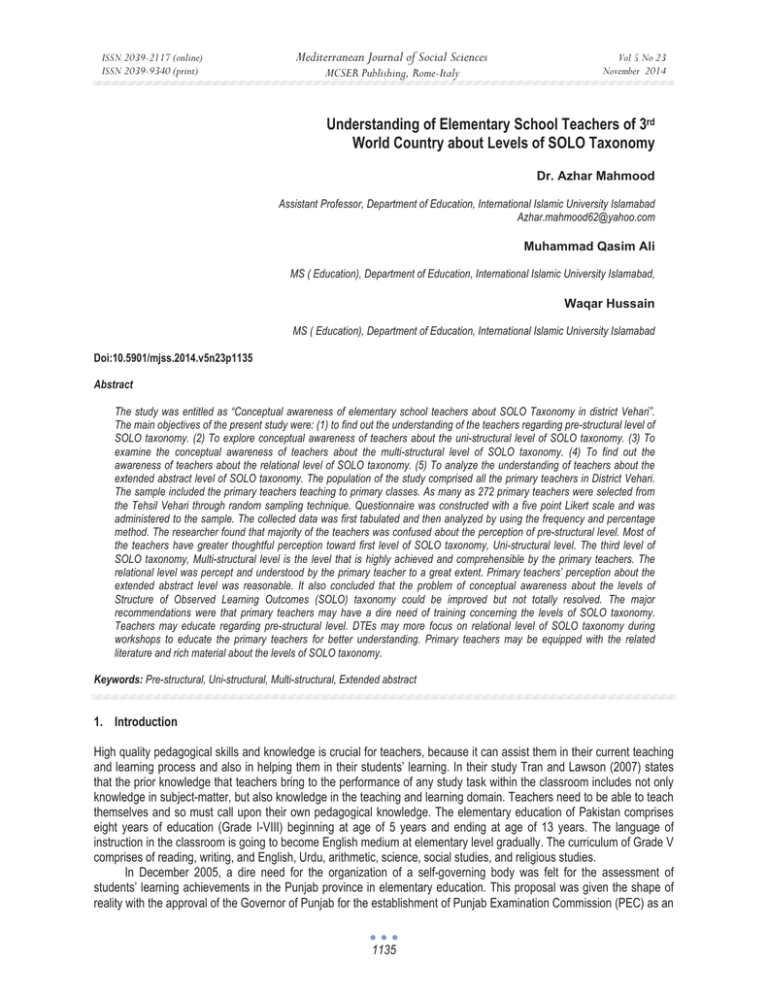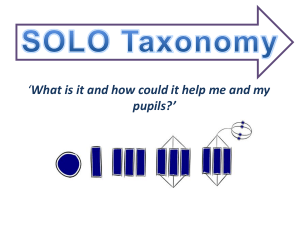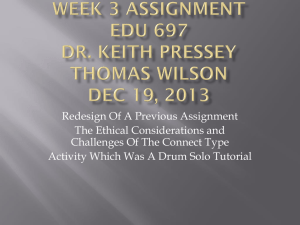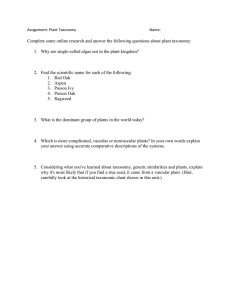Understanding of Elementary School Teachers of 3
advertisement

ISSN 2039-2117 (online) ISSN 2039-9340 (print) Mediterranean Journal of Social Sciences MCSER Publishing, Rome-Italy Vol 5 No 23 November 2014 Understanding of Elementary School Teachers of 3rd World Country about Levels of SOLO Taxonomy Dr. Azhar Mahmood Assistant Professor, Department of Education, International Islamic University Islamabad Azhar.mahmood62@yahoo.com Muhammad Qasim Ali MS ( Education), Department of Education, International Islamic University Islamabad, Waqar Hussain MS ( Education), Department of Education, International Islamic University Islamabad Doi:10.5901/mjss.2014.v5n23p1135 Abstract The study was entitled as “Conceptual awareness of elementary school teachers about SOLO Taxonomy in district Vehari”. The main objectives of the present study were: (1) to find out the understanding of the teachers regarding pre-structural level of SOLO taxonomy. (2) To explore conceptual awareness of teachers about the uni-structural level of SOLO taxonomy. (3) To examine the conceptual awareness of teachers about the multi-structural level of SOLO taxonomy. (4) To find out the awareness of teachers about the relational level of SOLO taxonomy. (5) To analyze the understanding of teachers about the extended abstract level of SOLO taxonomy. The population of the study comprised all the primary teachers in District Vehari. The sample included the primary teachers teaching to primary classes. As many as 272 primary teachers were selected from the Tehsil Vehari through random sampling technique. Questionnaire was constructed with a five point Likert scale and was administered to the sample. The collected data was first tabulated and then analyzed by using the frequency and percentage method. The researcher found that majority of the teachers was confused about the perception of pre-structural level. Most of the teachers have greater thoughtful perception toward first level of SOLO taxonomy, Uni-structural level. The third level of SOLO taxonomy, Multi-structural level is the level that is highly achieved and comprehensible by the primary teachers. The relational level was percept and understood by the primary teacher to a great extent. Primary teachers’ perception about the extended abstract level was reasonable. It also concluded that the problem of conceptual awareness about the levels of Structure of Observed Learning Outcomes (SOLO) taxonomy could be improved but not totally resolved. The major recommendations were that primary teachers may have a dire need of training concerning the levels of SOLO taxonomy. Teachers may educate regarding pre-structural level. DTEs may more focus on relational level of SOLO taxonomy during workshops to educate the primary teachers for better understanding. Primary teachers may be equipped with the related literature and rich material about the levels of SOLO taxonomy. Keywords: Pre-structural, Uni-structural, Multi-structural, Extended abstract 1. Introduction High quality pedagogical skills and knowledge is crucial for teachers, because it can assist them in their current teaching and learning process and also in helping them in their students’ learning. In their study Tran and Lawson (2007) states that the prior knowledge that teachers bring to the performance of any study task within the classroom includes not only knowledge in subject-matter, but also knowledge in the teaching and learning domain. Teachers need to be able to teach themselves and so must call upon their own pedagogical knowledge. The elementary education of Pakistan comprises eight years of education (Grade I-VIII) beginning at age of 5 years and ending at age of 13 years. The language of instruction in the classroom is going to become English medium at elementary level gradually. The curriculum of Grade V comprises of reading, writing, and English, Urdu, arithmetic, science, social studies, and religious studies. In December 2005, a dire need for the organization of a self-governing body was felt for the assessment of students’ learning achievements in the Punjab province in elementary education. This proposal was given the shape of reality with the approval of the Governor of Punjab for the establishment of Punjab Examination Commission (PEC) as an 1135 ISSN 2039-2117 (online) ISSN 2039-9340 (print) Mediterranean Journal of Social Sciences MCSER Publishing, Rome-Italy Vol 5 No 23 November 2014 autonomous body on January 16, 2006 with a difficult task to establish new setup. The first examination of G-5 under the supervision of Punjab Examination Commission was conducted in 2006 and onward. Punjab Examination Commission is the autonomous body to hold the examination of 5th and 8th classes in Punjab using SOLO technique. According to the official site of Punjab Examination Commission, SOLO method at first was design to instruct and to assist the teachers in institutions. SOLO taxonomy is cognitive approach taxonomy, developed by the two Australian fellows: Biggs and Collis in 1970s. The new examination system (SOLO taxonomy) in Pakistan serves as a record provides an act of advice to a wide variety of stakeholders within the education sector in province of Punjab. It provides advice to the Ministers, Executive District Officers (EDOs), Curriculum developers, Schools, parents, teachers and students. SOLO taxonomy précises the learning process for the students having different levels of ability to know, to do, and comprehend the task accordingly. SOLO taxonomy also facilitates in judging the worth of paper setting and examination system. The study was designed for the purpose of studying what awareness of teachers toward the levels of SOLO taxonomy, whether primary school teachers understand the levels of SOLO Taxonomy well or not. The teachers have conceptual awareness about SOLO taxonomy, for which they are ready to teach the students at elementary level all over the Punjab province. 2. Review of Related Literature Teachers use SOLO taxonomy in planning to recognize, describe, and create learning outcomes, learning experiences, and assessment for learning at different levels of cognitive intricacy to meet the enclosure of expectations, coherence and high expectations in the curriculum developmental objectives and achievement standards. Much like their students, teachers come up that SOLO clarifies their inquiry into instructive teaching practice, assisting them to monitor, regulate and reveal the efficacy of their teaching and produce more effective feedback in prompting next steps for learning. According to Canfield and Krockenberger (2002) SOLO taxonomy develops the teaching approach seemed a logical and a simple common-sense way of developing the students’ approval of the exploratory process in the subject. A teacher who has knowledge about the levels of SOLO taxonomy, certainly he can develop a level of understanding among the students through his dynamic teaching. Primarily, there are two types of approaches that are used in teaching process, the first one is constructivist approach and the next one is behaviorist approach. The straightforward argument holds that teachers who take up constructivist learning theories have different understanding of learning process from teachers who use a behaviorist approach. The former are apt to think of themselves as facilitators of the learning process in the classroom. It gives an opportunity to free exploration within an inquiry in the subject. The latter are more probable to see their role as one of ‘sagacious person on the stage’ whereby they introduce complex learning to the student in a series of small, progressive and mediated steps. In a real sense, elementary teachers’ complex tasks in classroom situation means they wants to end up playing the roles as facilitator, catalyst, sage and several others (Hook & Mills, 2011). For the purpose of assessment regarding students’ learning, some teachers search for social, linked and distributed learning outcomes in constructivist approach. Others seek clear, objective learning outcomes. In a live experience in a classroom situation, teachers’ understanding of SOLO Taxonomy helps teachers and students to comprehend learning regardless of their pedagogical approach. Lister, Simon, Thompson, Whalley & Prasad (2006) advocate that elementary teachers use a collection of assessment strategies and test the levels of SOLO taxonomy by students. Thompson (2007) asserted in his study that the SOLO taxonomy provides a series of categories based on the structural relationship of the material being presented in the phenomenon. The SOLO taxonomy model is a general framework for scientifically assessing quality of responses in the classroom by the students. The SOLO taxonomy can be used to set student learning outcomes or objectives for where students should be at particular levels of learning, to judge, to report on the student learning outcomes or the levels achieved in the current phenomena. According to Hook and Mills (2011) the SOLO taxonomy is a model framework of learning outcomes that helps institutions to develop a common understanding among the stakeholders in the institution. This framework systematically in so doing helps teachers and students to understand the learning process and learning outcomes. There are several research studies that investigate the usefulness and effective use of SOLO taxonomy in teacher education e.g. Prakash, Narayan & Sethuraman (2010), Padiotis & Mikropoulos (2010), Hook & Mills (2011), Thompson (2007), etc. while the use of SOLO taxonomy may play a vital and significant role in equipping elementary teachers with knowledge and skills in their dynamic teaching. 1136 Mediterranean Journal of Social Sciences ISSN 2039-2117 (online) ISSN 2039-9340 (print) Vol 5 No 23 November 2014 MCSER Publishing, Rome-Italy Levels of understanding in (SOLO) Taxonomy 1st Level Learning outcomes show isolated information with no organization 2nd Level 3rd Level Learning outcome Learning outcome shows shows simple connections are made, connections but but not significant parts importance of different to overall meaning is parts is not eminent. missing 4th Level 5th Level Learning outcome Learning outcome shows full go beyond subject connection-ns are and links are made, and synthesis made to other of parts to the whole ideas, and generalizations. 3. Methodology In the present study, the researcher used a descriptive survey design. The purpose of descriptive survey, according to Ezeani (1998), is to collect comprehensive and factual information that describes existing phenomenon. It contained itself with the present phenomena in terms of conditions, practices, beliefs, process, or trends. A researcher might choose to use quantitative surveys to gain data or to engage in a descriptive survey study of the current situation. However a researcher decides to approach the problem, the problem at hand will determine the method (Bryman, 1984). Population of the study was consisted of all the government primary school teachers in district Vehari. There are 3134 primary school teachers in the district Vehari. The researcher took sample from targeted population of Tehsil Vehari randomly. Gay, Mills, and Airasian (2008, p.125) prescribed a sample of 20% if the population size is around 1,500 individuals. So, for the present study 272 primary teachers of Tehsil Vehari were taken as sample. They were randomly selected from the list. As the study was descriptive in nature therefore a questionnaire for teachers was used to collect data. Hartas (2010, p. 261) has written that questionnaires are the most extensively used method for data-gathering in survey research. In order to get data from the respondents through the above mentioned research instrument, the researcher visited the target sample personally and administered the questionnaire to the sample teachers. They were thoroughly briefed about the procedure of filling the questionnaire. Data collected through the above-mentioned research instrument was tabulated, analyzed and interpreted in the light of the objectives of the study. 4. Analysis Table No.1 Awareness of primary teachers about the levels of SOLO taxonomy S. No. 1 2 3 4 5 Level Pre-structural level Uni-structural level Multi-structural level Relational level Extended Abstract level 35.3% 61.0% 54.8% 30.5% 34.6% 22.4% 27.2% 38.2% 28.3% 34.9% Responses 31.2% 58.5% 47.4% 31.2% 32% 26.5% 38.2% 34.2% 33.1% 27.2% 22.8% 42.6% 38.6% 31.6% 57.4% Table 1. Shows that maximum 35% and minimum 22.4%’ primary teachers are well aware about the pre-structural level of SOLO taxonomy. The above mentioned table indicates that maximum 61% and minimum 27.2% primary teachers have perception about uni-structural level of SOLO taxonomy. Maximum 54.8% and minimum 34.2% primary teachers are well versed about the multi-structural level of SOLO taxonomy. For relational level, maximum 33.1% and minimum 28.3% primary teachers are well aware. Whereas maximum 57.4% and minimum 27.2% primary teachers have perception about extended abstract level of SOLO taxonomy. 5. Conclusion The study reveals that majority of the teachers are not aware regarding the awareness of pre-structural level of SOLO taxonomy. Majority of the statements concerning pre-structural level, showed less awareness of teachers. Majority of the responses from teachers show the awareness of teachers about the uni-structural level of SOLO taxonomy are aware. Majority of the elementary teachers have awareness to some extent about the multi-structural level of SOLO taxonomy. Majority of the responses of teachers show that the concept of relational level of SOLO taxonomy is not understood and percept by the elementary teachers to a great extent. Majority of the responses from elementary teachers’ views that teacher’ awareness about the extended abstract level of SOLO taxonomy was to some extent. Overall study shows that majority of the teachers have less awareness about the level I (Pre-structural level) and level IV (Relational level) of 1137 ISSN 2039-2117 (online) ISSN 2039-9340 (print) Mediterranean Journal of Social Sciences MCSER Publishing, Rome-Italy Vol 5 No 23 November 2014 SOLO taxonomy. 6. Recommendations For the current scenario of the educational system in Punjab, it may recommend in the light of present study that primary teachers may educate regarding the levels of SOLO taxonomy. The study revealed that majority of the teachers was not well aware regarding pre-structural level of SOLO taxonomy. So teachers may educate regarding pre-structural level. Majority of the responses of teachers showed that the concept of relational level of SOLO taxonomy is not understood and percept by the primary teachers to a great extent. So DTEs may more focus on relational level of SOLO taxonomy during workshops to educate the teachers for better understanding. Directorate Staff Development (DSD) should ensure that there may be given more focus on level I (Pre-structural level) and level IV (Relational level) during the training of DTEs. Primary teacher may be equipped with the literature and rich material about the levels of SOLO taxonomy related to the contents of the syllabus. Trainers may educate the primary teachers about each level of the SOLO taxonomy individually and separately. References Biggs, J. B., & Collis, K. F. (1986). Evaluating the quality of learning – the SOLO taxonomy. New York: Academic Press. Bryman, A. (1984). The debate about quantitative and qualitative research: A question of method or epistemology. The British Journal of Sociology, 35, p.85. Canfield, P. J., & Krockenberger, M. B. (2002). An interactive, student-centered approach, adopting the SOLO taxonomy, for learning to analyze laboratory data in veterinary clinical pathology. Journal of Veterinary Medical Education, 29 (1), 56-61. Ezeani, S. I. (1998). Research methods: A realistic approach. Ibadan: Elohim publishers. Gay, L. R., Mills, G. E., Airasian, P. W. (2008). Educational research: Competencies for analysis and applications 9th ed. Prentice Hall. Hartas, D. (2010). Educational research inquiry: Qualitative and quantitative approaches 2nd ed. New York: Continuum International Publishing Group. Hook, P., & Mills, J. (2011). SOLO taxonomy: A guide for schools. Strawberry Hills: Essential Resources Educational Publishers Limited. Lister, R., Simon, B., Thompson, E., Whalley, J. L., & Prasad, C. (2006). Not seeing the forest for the trees: Novice programmers and the SOLO taxonomy. ITiCSE , 118122. Padiotis, I., & Mikropoulos, T. A. (2010). Using SOLO to evaluate an educational virtual environment in a technology education setting. Educational Technology and Society , 13 (3), 233-245. Prakash, E. S., Narayan, K. A., & Sethuraman, K. R. (2010). Student perceptions regarding the usefulness of explicit discussion of "Structure of the Observed Learning Outcome" taxonomy. Advances in Physiology Education , 34, 145-149. Thompson, E. (2007, January). Holistic assessment criteria – Applying SOLO to programming project. 66 . Australia: Conferences in Research in Practice in Information Technology. Tran, T. A., & Lawson, M. (2007). Students' pedagogical knowledge about teachers' use of questions. International Education Journal , 8 (2), 418-432. 1138





